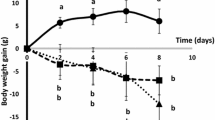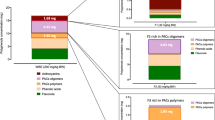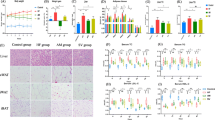Abstract
Purpose
Polyphenol metabolites are key mediators of the biological activities of polyphenols. This study aimed to evaluate the long-term effects of a high-fat high-sucrose (HFHS) diet on the metabolism of proanthocyanidins from grape seed extract (GSE).
Methods
Adult female Wistar–Kyoto rats were fed a standard (STD) or HFHS diet supplemented or not with GSE for 16 weeks. PA metabolites were determined by targeted HPLC–MS/MS analysis.
Results
A lower concentration of total microbial-derived PA metabolites was present in urine and the aqueous fraction of faeces in the HFHS + GSE group than in the STD + GSE group. In contrast, a tendency towards the formation of conjugated (epi)catechin metabolites in the HFHS + GSE group was observed.
Conclusions
These results show that a HFHS diet significantly modifies PA metabolism, probably via: (1) a shift in microbial communities not counteracted by the polyphenols themselves; and (2) an up-regulation of hepatic enzymes.
Similar content being viewed by others
Abbreviations
- EC:
-
(Epi)catechin
- EGC:
-
(Epi)gallocatechin
- Gluc:
-
Glucuronyl group
- GSE:
-
Grape seed extract
- HFHS:
-
High-fat high-sucrose diet
- Me:
-
Methyl group
- MetS:
-
Metabolic syndrome
- MRM:
-
Multiple reaction monitoring
- MS:
-
Mass spectrometry
- PA:
-
Proanthocyanidin
- STD:
-
Standard
- Sulf:
-
Sulphate group
References
Alberti KGMM, Eckel RH, Grundy SM, Zimmet PZ, Cleeman JI, Donato KA, Fruchart JC, James PT, Loria CM, Smith SC (2009) Harmonizing the metabolic syndrome: a joint interim statement of the international diabetes federation task force on epidemiology and prevention; National heart, lung, and blood institute; American heart association; World heart federation; International atherosclerosis society; and international association for the study of obesity. Circulation 120:1640–1645
Grundy SM (2008) Metabolic syndrome pandemic. Arterioscler Thromb Vasc Biol 28:629–636
Bourgoin F, Bachelard H, Badeau M, Melançon S, Pitre M, Larivière R, Nadeau A (2008) Endothelial and vascular dysfunctions and insulin resistance in rats fed a high-fat, high-sucrose diet. Am J Physiol Heart Circ Physiol 295:1044–1055
Ishimoto T, Lanspa MA, Rivard CJ, Roncal-Jiménez CA, Orlicky DJ, Cicerchi C, McMahan RH, Abdelmalek MF, Rosen HR, Jackman MR et al (2013) High-fat and high-sucrose (western) diet induces steatohepatitis that is dependent on fructokinase. Hepatology 58:1632–1643
Naderali EK, Williams G (2003) Prolonged endothelial-dependent and -independent arterial dysfunction induced in the rat by short-term feeding with a high-fat, high-sucrose diet. Atherosclerosis 166:253–259
Sato A, Kawano H, Notsu T, Ohta M, Nakakuki M, Mizuguchi K, Itoh M, Suganami T, Ogawa Y (2010) Antiobesity effect of eicosapentaenoic acid in high-fat/high-sucrose diet-induced obesity: importance of hepatic lipogenesis. Diabetes 59:2495–2504
Molinar-Toribio E, Pérez-Jiménez J, Ramos-Romero S, Gómez L, Taltavull N, Nogués MR, Adeva A, Jáuregui O, Joglar J, Clapés P et al (2015) d-Fagomine attenuates metabolic alterations induced by a high-energy-dense diet in rats. Food Funct 6:2614–2619
Mattison JA, Wang M, Bernier M, Zhang J, Park SS, Maudsley S, Ann SS, Santhanam L, Martin B, Faulkners S et al (2014) Resveratrol prevents high fat/sucrose diet-induced central arterial wall inflammation and stiffening in nonhuman primates. Cell Metab 20:183–190
Serrano J, Puupponen-Pimia R, Dauer A, Aura AM, Saura-Calixto F (2009) Tannins: current knowledge of food sources, intake, bioavailability and biological effects. Mol Nutr Food Res 53:310–329
Bladé C, Arola L, Salvadó MJ (2010) Hypolipidemic effects of proanthocyanidins and their underlying biochemical and molecular mechanisms. Mol Nutr Food Res 54:37–59
Barrett A, Ndou T, Hughey CA, Straut C, Howell A, Dai Z, Zaletunc G (2013) Inhibition of α-amylase and glucoamylase by tannins extracted from cocoa, pomegranates, cranberries, and grapes. J Agric Food Chem 61:1477–1486
Castell-Auví A, Cedó L, Pallarès V, Blay MT, Pinent M, Motilva MJ, García-Vallés S, Pujadas G, Maechler P, Ardévol A (2012) Procyanidins modify insulinemia by affecting insulin production and degradation. J Nutr Biochem 23:1565–1572
Fraga CG, Galleano M, Verstraeten SV, Oteiza PI (2010) Basic biochemical mechanisms behind the health benefits of polyphenols. Mol Asp Med 31:435–445
Pan MH, Lai CS, Ho CT (2010) Anti-inflammatory activities of natural flavonoids. Food Funct 1:15–31
Rodríguez-Mateos A, Vauzour D, Krueger CG, Shanmuganayagam D, Reed J, Calani L (2014) Bioavailability, bioactivity and impact on health of dietary flavonoids and related compounds: an update. Arch Toxicol 88:1803–1853
Williamson G, Clifford MN (2010) Colonic metabolites of berry polyphenols: the missing link to their biological activity? Br J Nutr 104:48–66
Urpí-Sardá M, Llorach R, Khan N, Monagas M, Rotches-Ribalta M, Lamuela-Raventós RM, Estruch R, Tinahones FJ, Andrés-Lacueva C (2010) Effect of milk on the urinary excretion of microbial phenolic acids after cocoa powder consumption in humans. J Agric Food Chem 58:4706–4711
Tulipani S, Martínez-Huélamo M, Rotchés M, Estruch R, Escribano E, Andrés-Lacueva C, Illán M, Lamuela-Raventós RM (2012) Oil matrix effects on plasma exposure and urinary excretion of phenolic compounds from tomato sauces: evidence from a human pilot study. Food Chem 30:581–590
Rodríguez-Mateos A, Cifuentes-Gómez T, González-Salvador I, Ottaviani JI, Schroeter H, Kelm M, Heiss C, Spencer JPE (2015) Influence of age on the absorption, metabolism, and excretion of cocoa flavanols in healthy subjects. Mol Nutr Food Res 59:1504–1512
Aoun M, Michel F, Fouret G, Jullien M, Wrutniak-Cabello C, Ramos J, Cristol JP, Coudray C, Carbonneau MA, Feillet-Coudray C (2010) A polyphenol extract modifies quantity but not quality of liver fatty acid content in high-fat-high-sucrose diet-fed rats: possible implication of the sirtuin pathway. Br J Nutr 104:1760–1770
Heber D, Zhang Y, Yang J, Ma JE, Henning SM, Li Z (2014) Green tea, black tea, and oolong tea polyphenols reduce visceral fat and inflammation in mice fed high-fat, high-sucrose obesogenic diets. J Nutr 144:1385–1393
Etxebarría L, Arias N, Boqué N, Macarulla MT, Portillo MP, Martínez JA, Milagro FI (2015) Reshaping faecal gut microbiota composition by the intake of trans-resveratrol and quercetin in high-fat sucrose diet-fed rats. J Nutr Biochem 26:651–660
Dudonné S, Varin TV, Anhê FF, Dubé P, Roy D, Pilon G, Marette A, Levy E, Jacquot C, Urdaci M et al (2015) Modulatory effects of a cranberry extract co-supplementation with Bacillus subtilis CU1 probiotic on phenolic compounds bioavailability and gut microbiota composition in high-fat diet-fed mice. PharmaNutrition 3:89–100
Touriño S, Fuguet E, Vinardell MP, Cascante M, Torres JL (2009) Phenolic metabolites of grape antioxidant dietary fiber in rat urine. J Agric Food Chem 57:11418–11426
Touriño S, Pérez-Jiménez J, Mateos-Martín ML, Fuguet E, Vinardell MP, Cascante M, Torres JL (2011) Metabolites in contact with the rat digestive tract after ingestion of a phenolic-rich dietary fiber matrix. J Agric Food Chem 59:5955–5963
Urpí-Sardá M, Garrido I, Monagas M, Gómez-Cordovés C, Medina-Remón A, Andrés-Lacueva C (2009) Profile of plasma and urine metabolites after the intake of almond [Prunus dulcis (Mill.) D.A. Webb] polyphenols in humans. J Agric Food Chem 57:10134–10142
Monagas M, Urpí-Sardá M, Sánchez-Patán F, Llorach R, Garrido I, Gómez-Cordovés C, Andrés-Lacueva C, Bartolomé B (2010) Insights into the metabolism and microbial transformation of dietary flavan-3ols and the bioactivity of their metabolites. Food Function 1:233–253
Choy YY, Quifer-Rada P, Holstege DM, Frese SA, Calvert CA, Mills DA, Lamuela-Raventós RM, Waterhouse AL (2014) Phenolic metabolites and substantial microbiome changes in pig feces by ingesting grape seed proanthocyanidins. Food Funct 5:2298–2308
Vitaglione p, Barone Lumaga R, Ferracane R, Sellitto S, Morelló JR, Requnat Miranda J, Shimoni E, Fogliano V (2012) Human bioavailability of flavanols and phenolic acids from cocoa-nut creams enriched with free or microencapsulated cocoa polyphenols. Br J Nutr 28:1832–1843
Li C, Lee MJ, Sheng S, Meng X, Prabhu S, Winnik B, Huang B, Chung JY, Yan S, Ho CT et al (2000) Structural identification of two metabolites of catechins and their kinetics in human urine and blood after tea ingestion. Chem Res Toxicol 13:177–184
Meng X, Sang S, Zhu N, Lu H, Sheng S, Lee MJ, Ho CT, Yang CS (2002) Identification and characterization of methylated and ring-fission metabolites of tea catechins formed in humans, mice, and rats. Chem Res Toxicol 15:1042–1050
Wishart D, Tzur D, Knox C, Eisner R, Guo AC, Young N, Cheng D, Jewell K, Arndt D, Sawhney S et al (2007) HMDB: the human metabolome database. Nucleic Acid Res 35:521–526
Gill CIR, McDougall CJ, Glidewell S, Stewart D, Shen Q, Tuohy K, Dobbin A, Boyd D, Brown D, Haldar S et al (2010) Profiling of phenols in human fecal water after raspberry supplementation. J Agric Food Chem 58:10389–10395
Scazzocchio B, Vari R, Filesi C, Del Gaudio I, D’Archivio M, Santangelo C, Iacovelli A, Galvano F, Pluchinotta FR, Gioannini C et al (2015) Protocatechuic acid activates key component of insulin signalling pathway mimicking insulin activity. Mol Nutr Food Res 59:1472–1481
Mora-Cubillos X, Tulipani S, García-Aloy M, Bulló M, Tinahones FJ, Andrés-Lacueva C (2015) Plasma metabolomics biomarkers of mixed nuts exposure inversely correlate with severity of metabolic syndrome. Mol Nutr Food Res 59:2480–2490
Ramos-Romero S, Molinar-Toribio E, Gómez L, Pérez-Jiménez J, Casado M, Clapés P, Piña B, Torres JL (2014) Effect of d-fagomine on excreted enterobacteria and weight gain in rats fed a high-fat high-sucrose diet. Obesity 2:976–979
Turnbaugh PJ, Ley RE, Mahowald MS, Magrini V, Mardis ER, Gordon JI (2006) An obesity-associated gut microbiome with increased capacity for energy harvest. Nature 444:1027–1131
Turnbaugh PJ, Hamady M, Yatsunenko T, Cantarel BL, Duncan A, Ley RE, Sogin ML, Jones WJ, Roe BA, Affourtit JP et al (2009) A core gut microbiome in obese and lean twins. Nature 457:480–484
Schwiertz A, Taras D, Schafer K, Beijer S, Bos NA, Donus C (2010) Microbiota and SCFA in lean and overweight healthy subjects. Obesity 18:190–195
Selma MV, Espín CJ, Tomás-Barberán FA (2009) Interaction between phenoliccs and gut microbiota: role in human health. J Agric Food Chem 57:6485–6501
Dueñas M, Cueva C, Muñoz-González I, Jiménez-Girón A, Sánchez-Patán F, Santos-Buelga C, Moreno-Arribas C, Bartolomé B (2015) Studies on modulation of gut microbiota by wine polyphenols: from isolated cultures to omic approaches. Antioxidants 4:1–21
Yamakoshi J, Tokutake S, Kikuchi M, Kubota Y, Konishi Y, Mitsuoka T (2001) Effect of proanthocyanidin-rich extract from grape seeds on human fecal flora and fecal odor. Microbiol Ecol Health Dis 13:25–31
De La Serre CB, Ellis CL, Lee J, Hartman AL, Rutledge JC, Raybould HE (2010) Propensity to high-fat diet-induced obesity in rats is associated with changes in the gut microbiota and gut inflammation. Am J Physiol Gastrointest Liver Physiol 299:440–448
Brinkworth GD, Noakes M, Clifton PM, Bird AR (2009) Comparative effects of very low-carbohydrate, high-fat and high-carbohydrate, low-fat weight-loss diets on bowel habit and faecal short-chain fatty acids and bacterial populations. Br J Nutr 101:1493–1502
Weltman MD, Farrell GC, Hall P, Ingelman-Sundberg M, Liddle C (1998) Hepatic cytochrome p450 2E1 is increased in patients with nonalcoholic steatohepatitis. Hepatology 27:128–133
Osabe M, Sugatani J, Fukuyama T, Ikushiro S, Ikari A, Miwa M (2008) Expression of hepatic UDP-glucuronosyltransferase 1A1 and 1A6 correlated with increased expression of the nuclear constitutive androstane receptor and peroxisome proliferator-activated receptor alpha in male rats fed a high-fat and high-sucrose diet. Drug Metab Dispos 36:294–302
Reagan-Shaw S, Nihal M, Ahmad N (2008) Dose translation from animal to human studies revisited. Faseb J 22:259–261
Knaze V, Zamora-Ros R, Luján-Barroso L, Romieu I, Scalbert A, Slimani N, Riboli E, Van Rossum CTM, Bueno-de-Mesquita HB, Trichopulou A et al (2012) Intake estimation of total and individual flavan-3-ols, proanthocyanidins and theaflavins, their food sources and determinants in the European Prospective Investigation into Cancer and Nutrition (EPIC) study. Br J Nutr 28:1095–1108
Yamakoshi J, Saito M, Kataoka S, Kikuchi M (2012) Safety evaluation of proanthocyanidin-rich extract from grape seeds. Food Chem Toxicol 40:599–607
Acknowledgments
Language revision by Christopher Evans is appreciated. This research was supported by the Spanish Ministry of Science and Innovation (Grants: AGL2009-12374-C03-01, -02 and -03; and AGL2013-49079-C2-1, 2 and -R, and through a doctoral fellowship to L.M.). The Panamanian Government (SENACYT/IFARHU) awarded a graduate fellowship to E.M.-T. The ISCIII is acknowledged for a “Sara Borrell” postdoctoral contract to J.P.-J. (CD09/00068). The funding sources did not have any role in the study design; in the collection, analysis and interpretation of data; in the writing of the report; and in the decision to submit the article for publication.
Author information
Authors and Affiliations
Corresponding author
Ethics declarations
Conflict of interest
The authors declare that they have no conflict of interest.
Electronic supplementary material
Below is the link to the electronic supplementary material.
Rights and permissions
About this article
Cite this article
Molinar-Toribio, E., Fuguet, E., Ramos-Romero, S. et al. A high-fat high-sucrose diet affects the long-term metabolic fate of grape proanthocyanidins in rats. Eur J Nutr 57, 339–349 (2018). https://doi.org/10.1007/s00394-016-1323-9
Received:
Accepted:
Published:
Issue Date:
DOI: https://doi.org/10.1007/s00394-016-1323-9




